 |
||
|
||
| ||
Part 3: Performance in GamesBenchmarksYou can look up the testbed configuration here We used the following test applications:
Test results are available in MS Excel tables: RAR and ZIP. If you are familiar with 3D graphics, you will understand our diagrams and draw your own conclusions. However, if you are interested in our comments on test results, you may read them after each test. Anything that is important to beginners and those who are new to the world of video cards will be explained in detail in the comments. First of all, you should look through our reference materials on modern graphics cards and their GPUs. Be sure to note the operating frequencies, support for modern technologies (shaders), as well as the pipeline architecture. You should understand that the 8800 family of accelerators abolished the notion of a pipeline. These cards have streaming processors, which process shader commands in a game. Texture units process pixels (applying textures, filtering) by themselves, that is the processes are fully divided. Data are written into a memory buffer, as always, only after texture operations. The old procedure was to take a triangle, calculate it with shader commands, apply texture(s), filter it, and send it along; that's not the case now. It's up to a driver and a thread processor to distribute tasks between stream processors. The same thing with texture units. ATI RADEON X1300-1600-1800-1900 Reference NVIDIA GeForce 7300-7600-7800-7900-8800 Reference If you have just begun realizing how large the selection to choose a video card is, don't worry, our 3D Graphics section offers articles about 3D basics (you will still have to understand them - when you run a game and open its options, you'll see such notions as textures, lighting, etc) as well as new product reviews. There are presently two companies that manufacture popular GPUs: AMD (its ATI department is responsible for graphics cards) and NVIDIA. We can also mention Matrox, S3. However, their share of the discrete graphics market is less than 1%, so we can discard them. So most of the information is divided into these two sections. We also publish monthly 3Digests that sum up all comparisons of graphics cards for various price segments. The February 2007 issue analyzed dependence of modern graphics cards on processors without antialiasing and anisotropic filtering. The March 2007 issue did the same with AA and AF. Thirdly, have a look at the test results. S.T.A.L.K.E.R.Test result charts: S.T.A.L.K.E.R.
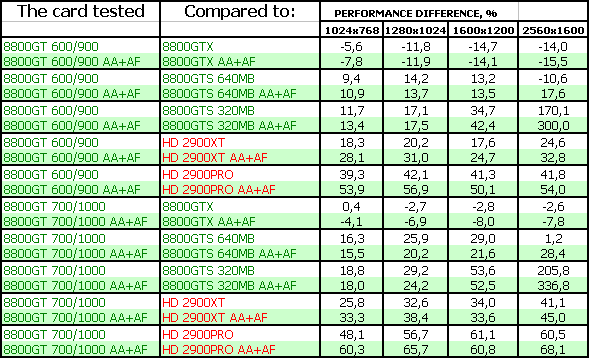 Even though it's a relatively new game, it has been in development for a long time. So it had to use old methods and a great many textures. Thus, texturing units play the most important role there. That's why the 8800GT is outperformed by the 8800GTX. But competition with the 8800GTS is different: that's natural, because the clock rate and more shader units do their part. Interestingly, a wider memory bus does not save the 8800GTS. Advantage of the AMD cards does not need any comments: more expensive cards are defeated. What concerns the overclocked card from Zotac, it's a triumph! It's only several per cents slower than the 8800 GTX! The diagrams do not contain results of the BFG card. But judging by its frequencies, its results will be a tad higher than those of the Forsa product (it's a reference card), and lower than results of the Zotac card.
CRYSIS (demo), DX9Test result charts: CRYSIS (demo), DX9
 This new game has very high requirements to shader units, and its requirements to texturing performance are also high. That's why video memory size plays the pivotal role in 2560x1600. The 8800GT is outperformed only by the 8800GTX, which has higher memory bandwidth, more processors and video memory. What concerns other competitors, the new product fares very well against them. The BFG card demonstrates even better results. The card from Zotac demonstrates phenomenal results, working almost on a par with the 8800GTX. It's outperformed only in high resolutions, where gameplay is below the acceptable level, so these modes are of little interest. What can we say? That's peachy for a $250-$300 card!
CRYSIS (demo), DX10Test result charts: CRYSIS (demo), DX10
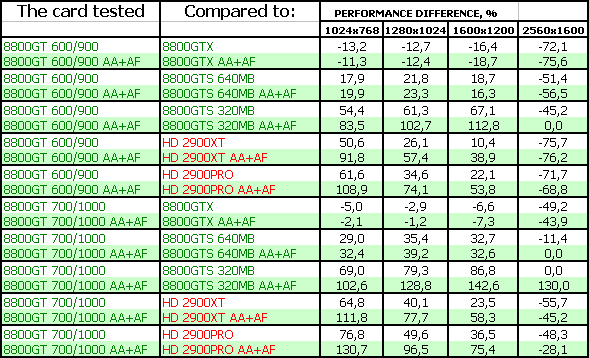 Now we'll run this game in Vista and enable a high quality mode that uses DX10 features. As we can see, the 8800GT lost some ground - 128 unified processors, 768 MB of memory, and a 384-bit bus in the 8800GTX make themselves felt, while the core clock is lower by just 25 MHz than in the new card. However, the BFG card can demonstrate a tad higher performance. The 8800GT from Zotac comes close to the 8800GTX only owing to its overclocking. What concerns other competitors, they are trashed. One important note. Even the latest NVIDIA driver didn't fix one serious bug: reflections on water are drawn with a big delay, that is there is a certain lag inside a scene. It has to do with optimizations for this game - if you rename the EXE file of the game, this lag disappears, but the game becomes slower. That is NVIDIA developers draw reflections with the lag of several frames. That is, one draw, five skips. That's why reflections are jerking, which produces an impression of lagging.
Splinter Cell Chaos Theory (HDR)Test result charts: SCCT (HDR)
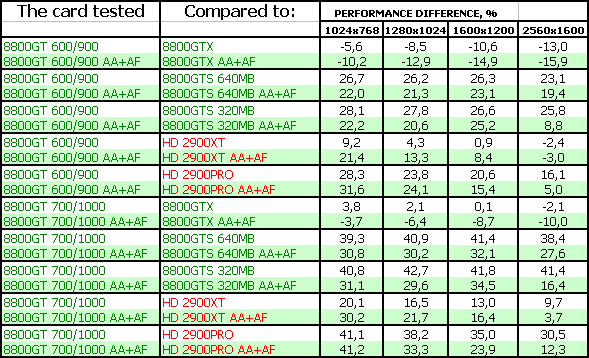 This game also has high requirements to shader units (even though the game is relatively old), which creates favorable conditions for the new card. Moreover, the overclocked card from Zotac even outperforms the 8800GTX flagship in the easy mode. However, AA+AF do their part, and higher memory bandwidth of the 8800GTX helps the card to remain a leader.
Call Of Juarez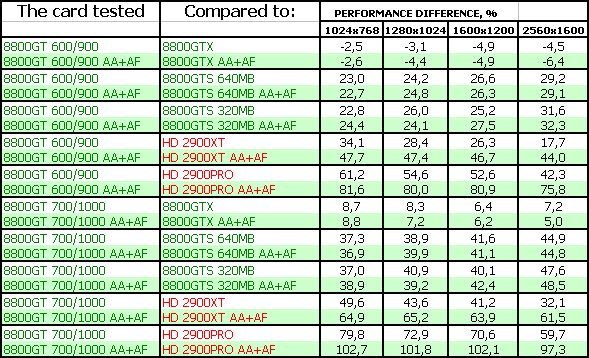 The new card from NVIDIA performs even more gloriously in this test. The Zotac product has become an ABSOLUTE leader, it's the fastest card! It's a phenomenal success, considering that the 8800GTX is at least twice as expensive as the 8800GT.
Company Of Heroes This is not as brilliant, but it's still very good for the new NVIDIA product, especially from Zotac.
Serious Sam II (HDR) This game sticks to the old ways with lots of textures. So it depends much on the speed and number of texture units and ROPs (although shader units are also important). That's why the new product is outperformed not only by the 8800GTX. It's also a tad slower than the 8800GTS. Considering that overclocking does not yield much to Zotac here, the situation with the BFG card will be identical.
Prey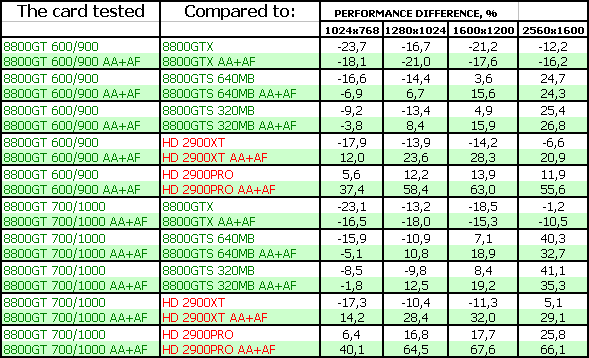 It's almost a similar situation. Cut-down performance of texture units (as the number of TMUs is increased, they have become more primitive) makes the new cards slower in old games, especially OGL, than the old cards, if the latter have higher resources as far as memory bandwidth, TMU, and other aspects are concerned.
3DMark05: MARKSTest result charts: 3DMark05 MARKS
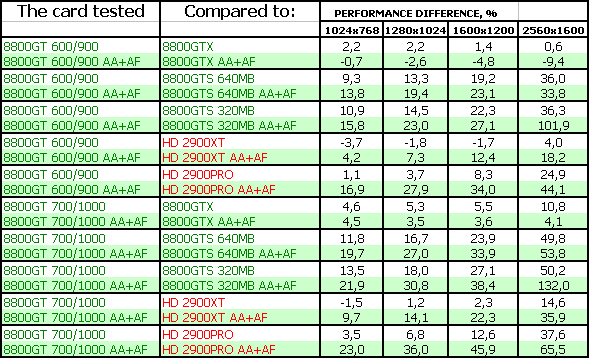 As soon as we start a test that depends on shader units, the new cards shoot forward. This test proves this fact.
3DMark06: SHADER 2.0 MARKSTest result charts: 3DMark06 SM2.0 MARKS
 3DMark06: SHADER 3.0 MARKSTest result charts: 3DMark06 SM3.0 MARKS
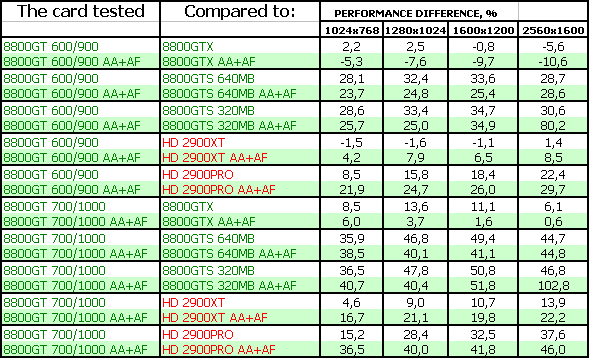 You can see that all three 3DMark tests give similar results. ConclusionsNVIDIA GeForce 8800 GT (G92) 512MB PCI-E demonstrates phenomenal results almost in all tests! We've never come across a situation, when a cheaper card outperforms more expensive products, which are still available in stores and are not discontinued. NVIDIA has done an impossible thing: it "killed" the 8800GTS (both modifications) and the 8800GTX with one stone. Who will want to pay $600 for the GTX card, if you can buy a $300 card, which can come close to the flagship in a number of tests! To say nothing of the RADEON HD 2900XT, which is outperformed by the new card in every respect! And which consumes much more power, has bigger dimensions, and is much noisier. But there is still a fly in the ointment. We speak about CRYSIS. Yep, about those optimizations, because of which reflections on the water are not drawn each frame. It spoils the overall impression, although it appears only in DX10 Very High mode. As if the developers were desperate to accelerate the game. And they did it haphazardly. When the article was ready to be published, we received information from BFG Russia that NVIDIA promised to fix all problems in CRYSIS in the official release of drivers by the time the game comes out officially. As of the card itself, high heat dissipation is its big drawback. It's strange to see a graphics card manufactured by the new process technology to dissipate so much heat. Theoretically, we should have seen something of the 7800GTX-7900GTX transition effect: much higher clock rates, and much lower heat release. NVIDIA apparently made a mistake somewhere. The same concerns the cooler. Such a card must be equipped with a cooling system that blows the hot air out of a system unit. Not just stirs the hot air inside. As a result, the 8800GT has another drawback - a noisy cooling system. NVIDIA again chose a wrong cooler. Remember the 7900GTX and its excellent two-slot quiet cooler! Yep, it occupied two slots. But it was very quiet. Why discard old good solutions and install narrow coolers, if users will have to solve the problem of noise? A two-slot cooler is not a drawback anymore. In 95% of cases a PCI-Ex16 slot is followed by a PCI-Ex1, and there are almost no expansion cards for this slot in the market. So it can be safely blocked by a graphics card's cooler. Besides, there are noiseless narrow coolers as well. For example, a cooling system from Zotac. An excellent solution! The same dimensions, but the fan rotates at 800 rpm, there is no noise. Cooling efficiency is higher, because the card is overclocked. Why couldn't NVIDIA use the same solution? It's no secret that all 8800 cards are sold by NVIDIA to its partners. They do not manufacture cards on their own. So 80% of the cards will be equipped with the reference cooling system installed by NVIDIA's orders. They won't change the cooler. And users will have to suffer from noise. That's not right. So we should praise Zotac for such a good solution and for their card in general, which is faster than the 8800GTX in some cases. We'd like to mention the nice looking box as well. By the way, this cooler is also illuminated with orange LEDs. What concerns the BFG product, it has all cooling problems of the card from Forsa (reference card), but also features a great advantage - higher frequencies (not much higher, though). The cooler has a sticker that glows in ultraviolet light. The box is dull and looks as if it was designed in a hurry. The company used to offer more attractive designs. But box dimensions are very convenient for retailers. Here goes the main conclusion. The 8800 GT "killed" the 8800GTS. Overclocked modifications of the new card are even better than the 8800 GTX, because the price of the new card is much lower than those for the above mentioned competitors. The 8800 GT also sent the 2900 XT to retirement. Conclusion: either the 8800GTS/GTX will disappear soon, or their prices will drop. Just like for the 2900 XT. Users will benefit either way. Good news, everyone! And another thing that we are not tired to repeat from article to article. Having decided to choose a graphics card by yourself, you have to realize you're to change one of the fundamental PC parts, which might require additional tuning to improve performance or enable some qualitative features. This is not a finished product, but a component part. So, you must understand that in order to get the most from a new graphics card, you will have to acquire some basic knowledge of 3D graphics and graphics in general. If you are not ready for this, you should not perform upgrades by yourself. In this case it would be better to purchase a ready chassis with preset software (along with vendor's technical support,) or a gaming console that doesn't require any adjustments. To find more information regarding the current graphics card market and the performance of various cards, feel free to read our monthly special 3Digest.
The following card gets the Original Design award (November):  ZOTAC GeForce 8800 GT (G92) AMP Edition 512MB PCI-E For the provided graphics cards we'd like to thank:
Carsten Berger of ZOTAC Mikhail Proshletsov of BFG Russia Alexei Rodionov of Boston (Forsa)
Andrey Vorobiev (anvakams@ixbt.com)
November 30, 2007 Write a comment below. No registration needed!
|
Platform · Video · Multimedia · Mobile · Other || About us & Privacy policy · Twitter · Facebook Copyright © Byrds Research & Publishing, Ltd., 1997–2011. All rights reserved. |